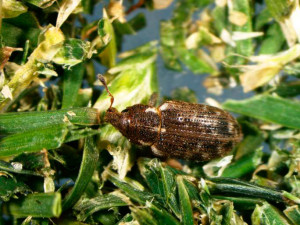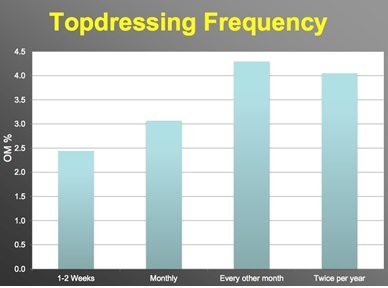 Pest management is a critical component of maintaining a playable and functional golf course. A fully implemented best management practices program demands the highest level of progressive Integrated Pest Management (IPM).
Pest management is a critical component of maintaining a playable and functional golf course. A fully implemented best management practices program demands the highest level of progressive Integrated Pest Management (IPM).
Progressive IPM observes and records pest pressure, uses predictive approaches to assessing injury risk, considers intervention with lowest environmental impact, and assesses performance of intervention for integration in pest management programs. This summer, when you consider intervention to control pests that includes the use of pesticides, consider products with the lowest environmental impact. This idea is identified in the two BMP statements:
Determine least toxic pest control programs including preventive approaches.
Recognize environmental fate of pesticides and select pesticides using a selection strategy that includes an evaluation of pesticide characteristics and potential for nontarget effects.
When pesticide use is warranted, the selection of pesticide should include an evaluation of economics, efficacy, and the environment. An additional factor such as application method should be considered as well in those cases where liquid spray is more effective than granular products or has a lower environmental impact.
A simple method to assess the reduction in environmental impact can be performed by simply calculating the pounds of active ingredients of products used and striving each year to reduce those totals. However, this simple method neglects any potential variability in toxicity, which could be accounted for by using a percentage of reduced risk or biological products for pest control.
A number of pesticide risk assessment models are available from a variety of government, university and private sources to use for more precise environmental impact estimations. These models utilize toxicity, exposure, and persistence data to provide a numerical value that integrates a number of human health and environmental impacts. For example, the Quebec Pesticide Risk Indicator (QPRI) has different assessment models for human health (QPRI-Health) and a separate number for environmental impacts (QPRI-Environment). These measure various factors and provide the user information for product selection and cumulative environmental impact during a season.
The Cornell Turfgrass Program uses the Environmental Impact Quotient developed by the NYS IPM Program and adapted for use in turfgrass systems. Like the QPRI, the EIQ assesses the toxicity for the applicator and golfer as well as environmental fate and persistence characteristics. A numerical value is determined for a product, then adjusted for field use rate and finally the treated acreage.
Both these approaches have limitations; however, over time, regardless of the tool used, it is critical to attempt to measure and monitor the risk associated with pest management programs.
An excellent example of the risk assessment approach is available in the Case Studies section of this website, in the Reducing the Environmental Impact of Pest Management case study at Soaring Eagles Golf Course. The golf course management staff at Soaring Eagles Golf Course implemented the EIQ approach over a five-year period to target reducing risk associated with pest management and specifically with dollar spot control. The case study concluded the following:
“Soaring Eagles quickly adapted the chemical substitutions of lower FUEIQ products with the same or improved efficacies, still considering resistance management. Strategic equipment investment created opportunity for specific cultural operations that directly reduced pest pressure and improve plant vigor. Five years later, there is a 28 percent reduction in the overall FUEIQ –Acres. More significantly, the course has reduced the use of higher FUEIQ-value chemicals by 57%.”
The spectrum of good, better, and best practices for reducing risk associated with pest management program are as follows:
The good pest management program:
- Establishes non-resource limiting (light, air, drainage, etc.) growing environments as a preventative cultural management strategy.
- Practices good recordkeeping of historical pest populations and impact of pest pressure that notes injury.
- Monitors existing pest pressure and impact of current and forecasted weather conditions to determine predict risk level and degree of intervention required to maintain visual and functional quality.
- Implements an intervention strategy with an understanding of the environmental impact (EPA label) and the potential disruption due to damage associated with pest pressure.
- Assesses results of intervention and annually reviews practices and products.
The better pest management program:
- Minimizes pest importation by maintaining clean planting material (sod, seed, topsoil, etc.)
- Establishes non-resource limiting (light, air, drainage, etc.) growing environments as preventative cultural management strategy
- Adapts cultural practices to manage abiotic (temperature, moisture and traffic) stress
- Practices good recordkeeping of properly diagnosed historical pest populations and images of impact of pest pressure that notes injury, damage, and objectionable reduction in visual or functional quality
- Monitors existing pest pressure and impact of current and forecasted weather conditions to determine degree of intervention required to maintain visual and functional quality
- Implements intervention strategy with full understanding of the environmental impact as determined by two sources (EPA, EIQ, QPRI, etc.) and commensurate with the expected level of disruption due to damage associated with pest pressure.
- Assesses results of intervention and records a detailed a review of the practices and products.
The best pest management program:
- Minimizes pest importation by maintaining clean planting material (sod, seed, topsoil, etc.).
- Establishes non-resource limiting (light, air, drainage, etc.) growing environments as preventative cultural management strategy.
- Adapts cultural practices to manage abiotic (temperature, moisture and traffic) stress.
- Practices GIS-based recordkeeping of properly diagnosed historical pest populations and GIS-based images of impact of pest pressure that notes injury, damage, and objectionable reduction in visual or functional quality.
- Monitors existing pest pressure and in combination with weather-based published predictive models, on-line pest population ecology, to determine degree of intervention required to maintain visual and functional quality.
- Implements intervention strategy with full understanding of the environmental impact as determined by three sources (EPA, EIQ, QPRI, etc.) and commensurate with the expected level of disruption due to damage associated with pest pressure and impact on revenue from documented said conditions.
- Assesses results of intervention and records a detailed a review of the practices and products including an economic cost analysis that recognizes labor, energy, and facility revenue impacts.


